Attached files
| file | filename |
|---|---|
| 8-K - 8-K - W R GRACE & CO | a022020presentation8-k.htm |

Investor Presentation February 10, 2020
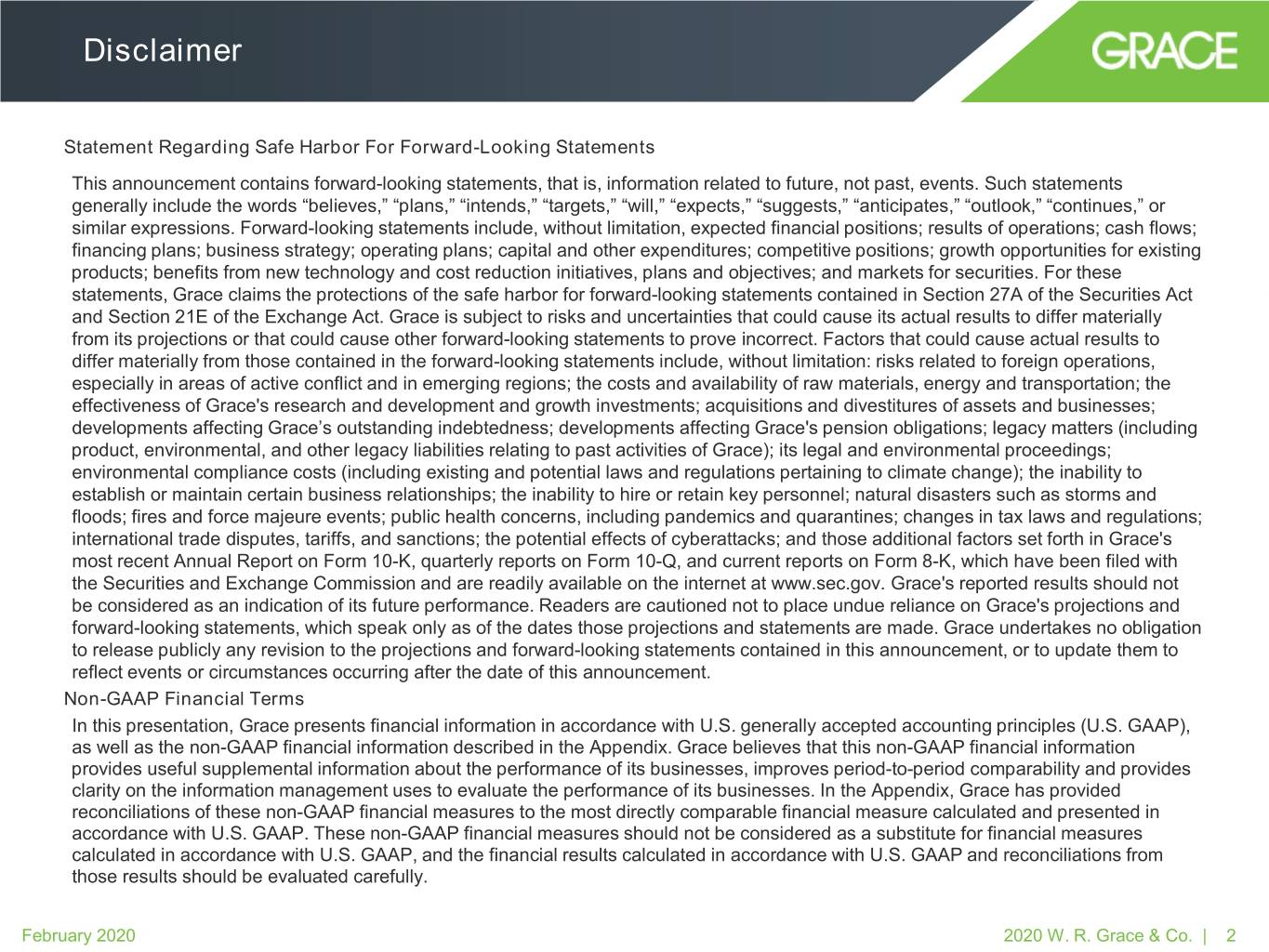
Disclaimer Statement Regarding Safe Harbor For Forward-Looking Statements This announcement contains forward-looking statements, that is, information related to future, not past, events. Such statements generally include the words “believes,” “plans,” “intends,” “targets,” “will,” “expects,” “suggests,” “anticipates,” “outlook,” “continues,” or similar expressions. Forward-looking statements include, without limitation, expected financial positions; results of operations; cash flows; financing plans; business strategy; operating plans; capital and other expenditures; competitive positions; growth opportunities for existing products; benefits from new technology and cost reduction initiatives, plans and objectives; and markets for securities. For these statements, Grace claims the protections of the safe harbor for forward-looking statements contained in Section 27A of the Securities Act and Section 21E of the Exchange Act. Grace is subject to risks and uncertainties that could cause its actual results to differ materially from its projections or that could cause other forward-looking statements to prove incorrect. Factors that could cause actual results to differ materially from those contained in the forward-looking statements include, without limitation: risks related to foreign operations, especially in areas of active conflict and in emerging regions; the costs and availability of raw materials, energy and transportation; the effectiveness of Grace's research and development and growth investments; acquisitions and divestitures of assets and businesses; developments affecting Grace’s outstanding indebtedness; developments affecting Grace's pension obligations; legacy matters (including product, environmental, and other legacy liabilities relating to past activities of Grace); its legal and environmental proceedings; environmental compliance costs (including existing and potential laws and regulations pertaining to climate change); the inability to establish or maintain certain business relationships; the inability to hire or retain key personnel; natural disasters such as storms and floods; fires and force majeure events; public health concerns, including pandemics and quarantines; changes in tax laws and regulations; international trade disputes, tariffs, and sanctions; the potential effects of cyberattacks; and those additional factors set forth in Grace's most recent Annual Report on Form 10-K, quarterly reports on Form 10-Q, and current reports on Form 8-K, which have been filed with the Securities and Exchange Commission and are readily available on the internet at www.sec.gov. Grace's reported results should not be considered as an indication of its future performance. Readers are cautioned not to place undue reliance on Grace's projections and forward-looking statements, which speak only as of the dates those projections and statements are made. Grace undertakes no obligation to release publicly any revision to the projections and forward-looking statements contained in this announcement, or to update them to reflect events or circumstances occurring after the date of this announcement. Non-GAAP Financial Terms In this presentation, Grace presents financial information in accordance with U.S. generally accepted accounting principles (U.S. GAAP), as well as the non-GAAP financial information described in the Appendix. Grace believes that this non-GAAP financial information provides useful supplemental information about the performance of its businesses, improves period-to-period comparability and provides clarity on the information management uses to evaluate the performance of its businesses. In the Appendix, Grace has provided reconciliations of these non-GAAP financial measures to the most directly comparable financial measure calculated and presented in accordance with U.S. GAAP. These non-GAAP financial measures should not be considered as a substitute for financial measures calculated in accordance with U.S. GAAP, and the financial results calculated in accordance with U.S. GAAP and reconciliations from those results should be evaluated carefully. February 2020 2020 W. R. Grace & Co. | 2

About Grace 3
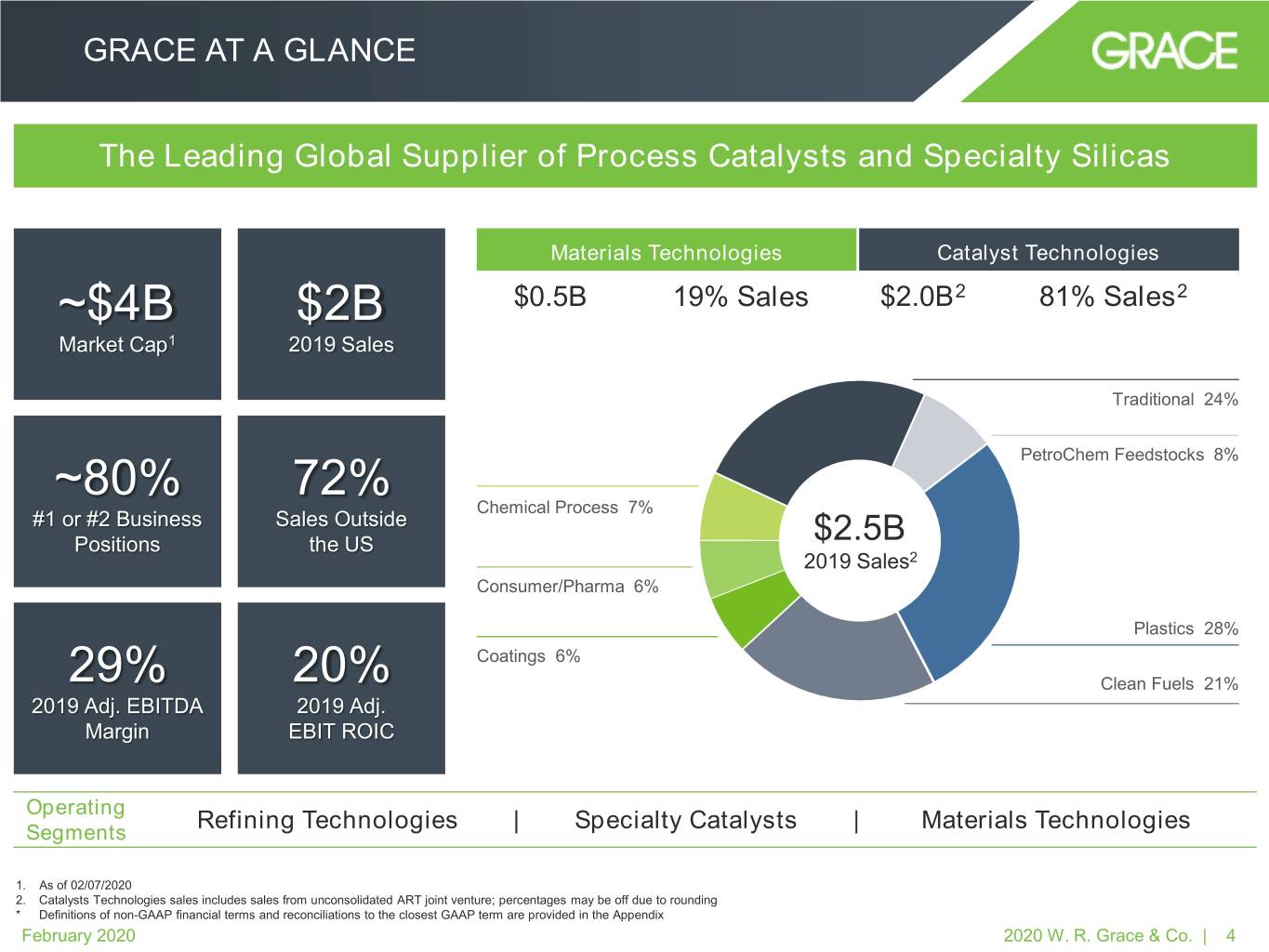
GRACE AT A GLANCE The Leading Global Supplier of Process Catalysts and Specialty Silicas Materials Technologies Catalyst Technologies ~$4B $2B $0.5B 19% Sales $2.0B2 81% Sales2 Market Cap1 2019 Sales Traditional 24% PetroChem Feedstocks 8% ~80% 72% Chemical Process 7% #1 or #2 Business Sales Outside Positions the US $2.5B 2019 Sales2 Consumer/Pharma 6% Plastics 28% Coatings 6% 29% 20% Clean Fuels 21% 2019 Adj. EBITDA 2019 Adj. Margin EBIT ROIC Operating Segments Refining Technologies | Specialty Catalysts | Materials Technologies 1. As of 02/07/2020 2. Catalysts Technologies sales includes sales from unconsolidated ART joint venture; percentages may be off due to rounding * Definitions of non-GAAP financial terms and reconciliations to the closest GAAP term are provided in the Appendix February 2020 2020 W. R. Grace & Co. | 4
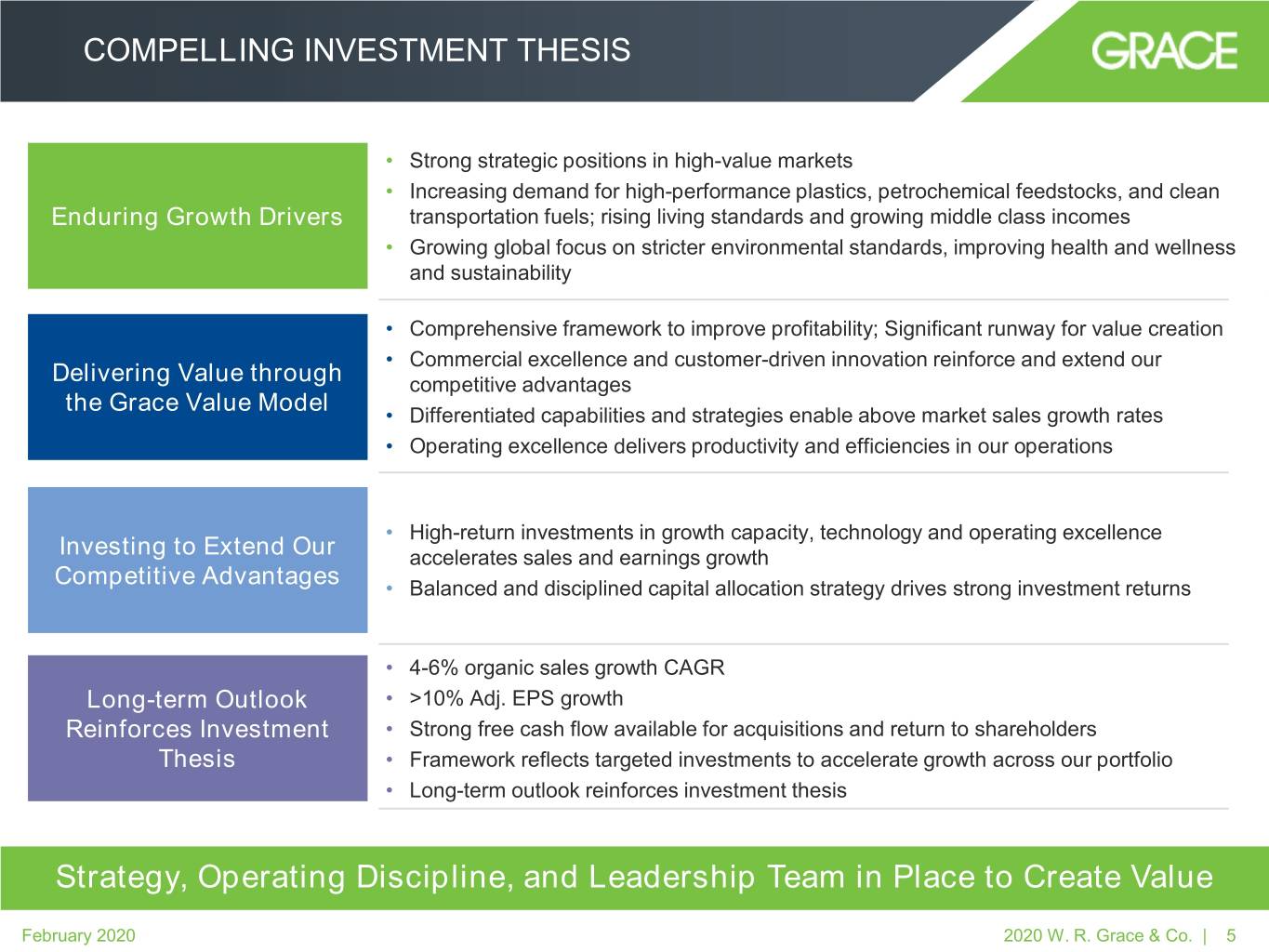
COMPELLING INVESTMENT THESIS • Strong strategic positions in high-value markets • Increasing demand for high-performance plastics, petrochemical feedstocks, and clean Enduring Growth Drivers transportation fuels; rising living standards and growing middle class incomes • Growing global focus on stricter environmental standards, improving health and wellness and sustainability • Comprehensive framework to improve profitability; Significant runway for value creation • Commercial excellence and customer-driven innovation reinforce and extend our Delivering Value through competitive advantages the Grace Value Model • Differentiated capabilities and strategies enable above market sales growth rates • Operating excellence delivers productivity and efficiencies in our operations • High-return investments in growth capacity, technology and operating excellence Investing to Extend Our accelerates sales and earnings growth Competitive Advantages • Balanced and disciplined capital allocation strategy drives strong investment returns • 4-6% organic sales growth CAGR Long-term Outlook • >10% Adj. EPS growth Reinforces Investment • Strong free cash flow available for acquisitions and return to shareholders Thesis • Framework reflects targeted investments to accelerate growth across our portfolio • Long-term outlook reinforces investment thesis Strategy, Operating Discipline, and Leadership Team in Place to Create Value February 2020 2020 W. R. Grace & Co. | 5
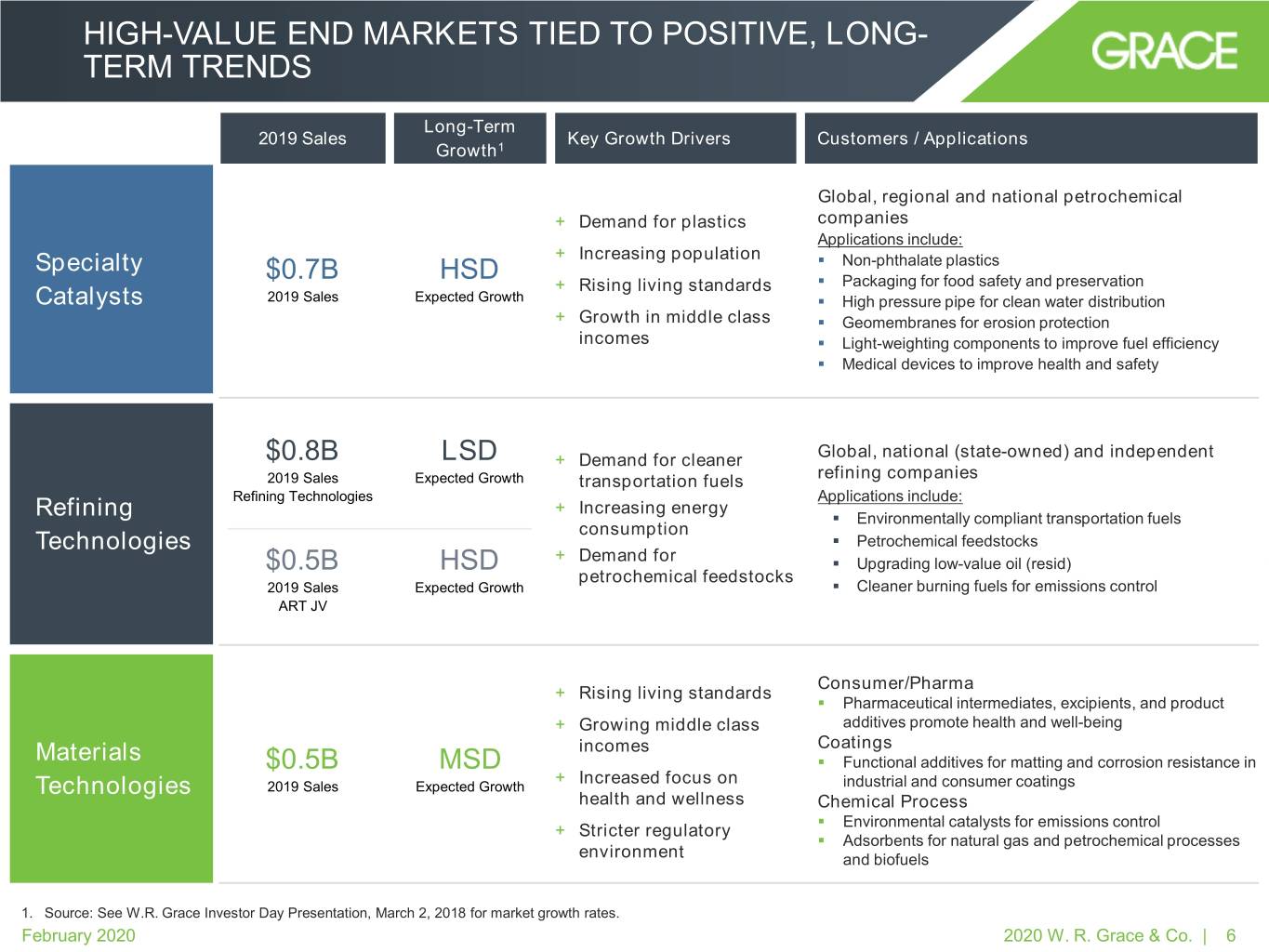
HIGH-VALUE END MARKETS TIED TO POSITIVE, LONG- TERM TRENDS Long-Term 2019 Sales Key Growth Drivers Customers / Applications Growth1 Global, regional and national petrochemical + Demand for plastics companies Applications include: Specialty + Increasing population . Non-phthalate plastics $0.7B HSD + Rising living standards . Packaging for food safety and preservation Catalysts 2019 Sales Expected Growth . High pressure pipe for clean water distribution + Growth in middle class . Geomembranes for erosion protection incomes . Light-weighting components to improve fuel efficiency . Medical devices to improve health and safety Global, national (state-owned) and independent $0.8B LSD + Demand for cleaner refining companies 2019 Sales Expected Growth transportation fuels Refining Technologies Applications include: + Increasing energy Refining . Environmentally compliant transportation fuels consumption Technologies . Petrochemical feedstocks + Demand for . Upgrading low-value oil (resid) $0.5B HSD petrochemical feedstocks 2019 Sales Expected Growth . Cleaner burning fuels for emissions control ART JV Consumer/Pharma + Rising living standards . Pharmaceutical intermediates, excipients, and product + Growing middle class additives promote health and well-being incomes Coatings Materials $0.5B MSD . Functional additives for matting and corrosion resistance in + Increased focus on Technologies 2019 Sales Expected Growth industrial and consumer coatings health and wellness Chemical Process . Environmental catalysts for emissions control + Stricter regulatory . Adsorbents for natural gas and petrochemical processes environment and biofuels 1. Source: See W.R. Grace Investor Day Presentation, March 2, 2018 for market growth rates. February 2020 2020 W. R. Grace & Co. | 6
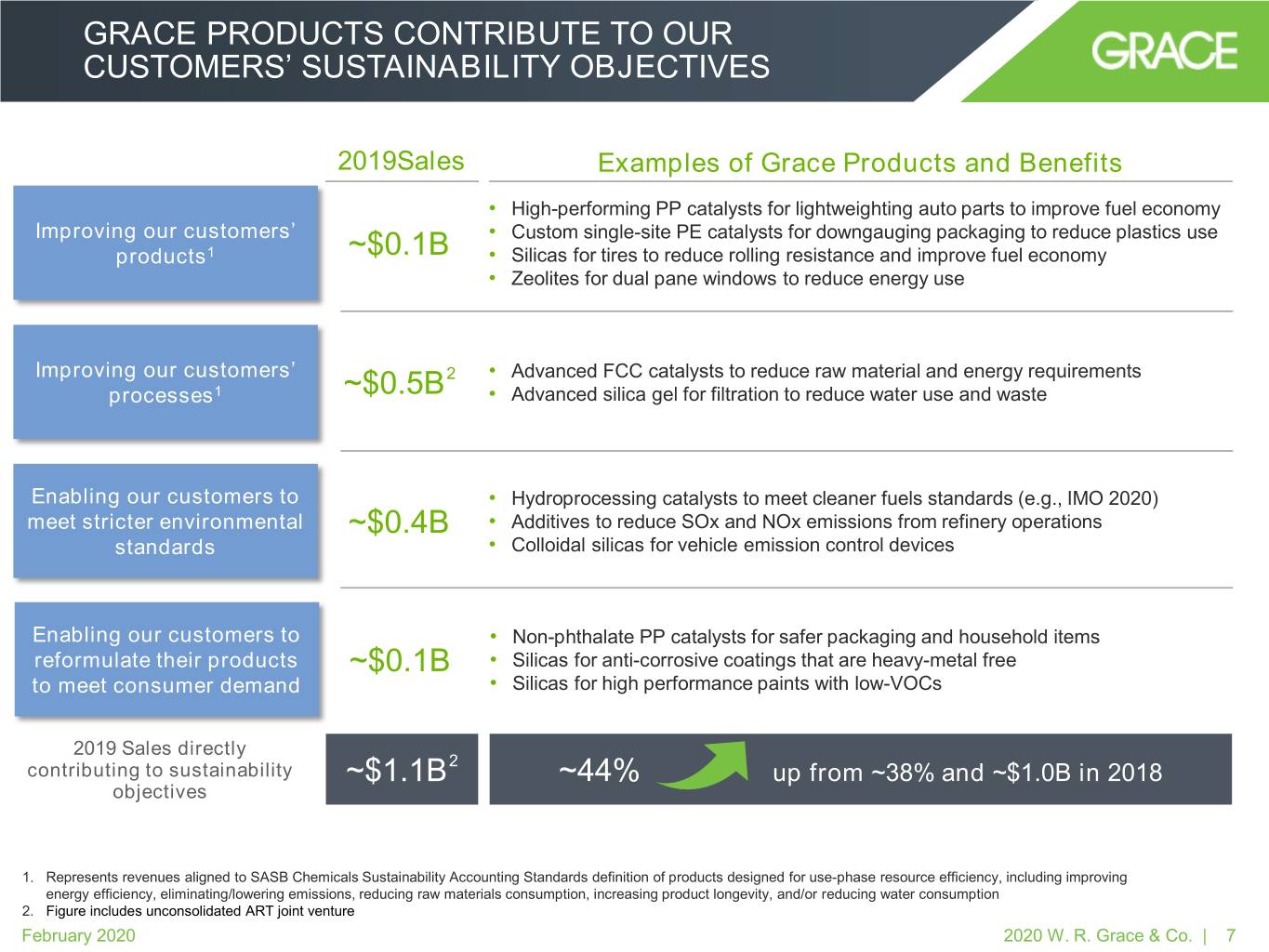
GRACE PRODUCTS CONTRIBUTE TO OUR CUSTOMERS’ SUSTAINABILITY OBJECTIVES 2019Sales Examples of Grace Products and Benefits • High-performing PP catalysts for lightweighting auto parts to improve fuel economy Improving our customers’ • Custom single-site PE catalysts for downgauging packaging to reduce plastics use products1 ~$0.1B • Silicas for tires to reduce rolling resistance and improve fuel economy • Zeolites for dual pane windows to reduce energy use Improving our customers’ 2 • Advanced FCC catalysts to reduce raw material and energy requirements processes1 ~$0.5B • Advanced silica gel for filtration to reduce water use and waste Enabling our customers to • Hydroprocessing catalysts to meet cleaner fuels standards (e.g., IMO 2020) meet stricter environmental ~$0.4B • Additives to reduce SOx and NOx emissions from refinery operations standards • Colloidal silicas for vehicle emission control devices Enabling our customers to • Non-phthalate PP catalysts for safer packaging and household items reformulate their products ~$0.1B • Silicas for anti-corrosive coatings that are heavy-metal free to meet consumer demand • Silicas for high performance paints with low-VOCs 2019 Sales directly 2 contributing to sustainability ~$1.1B ~44% up from ~38% and ~$1.0B in 2018 objectives 1. Represents revenues aligned to SASB Chemicals Sustainability Accounting Standards definition of products designed for use-phase resource efficiency, including improving energy efficiency, eliminating/lowering emissions, reducing raw materials consumption, increasing product longevity, and/or reducing water consumption 2. Figure includes unconsolidated ART joint venture February 2020 2020 W. R. Grace & Co. | 7
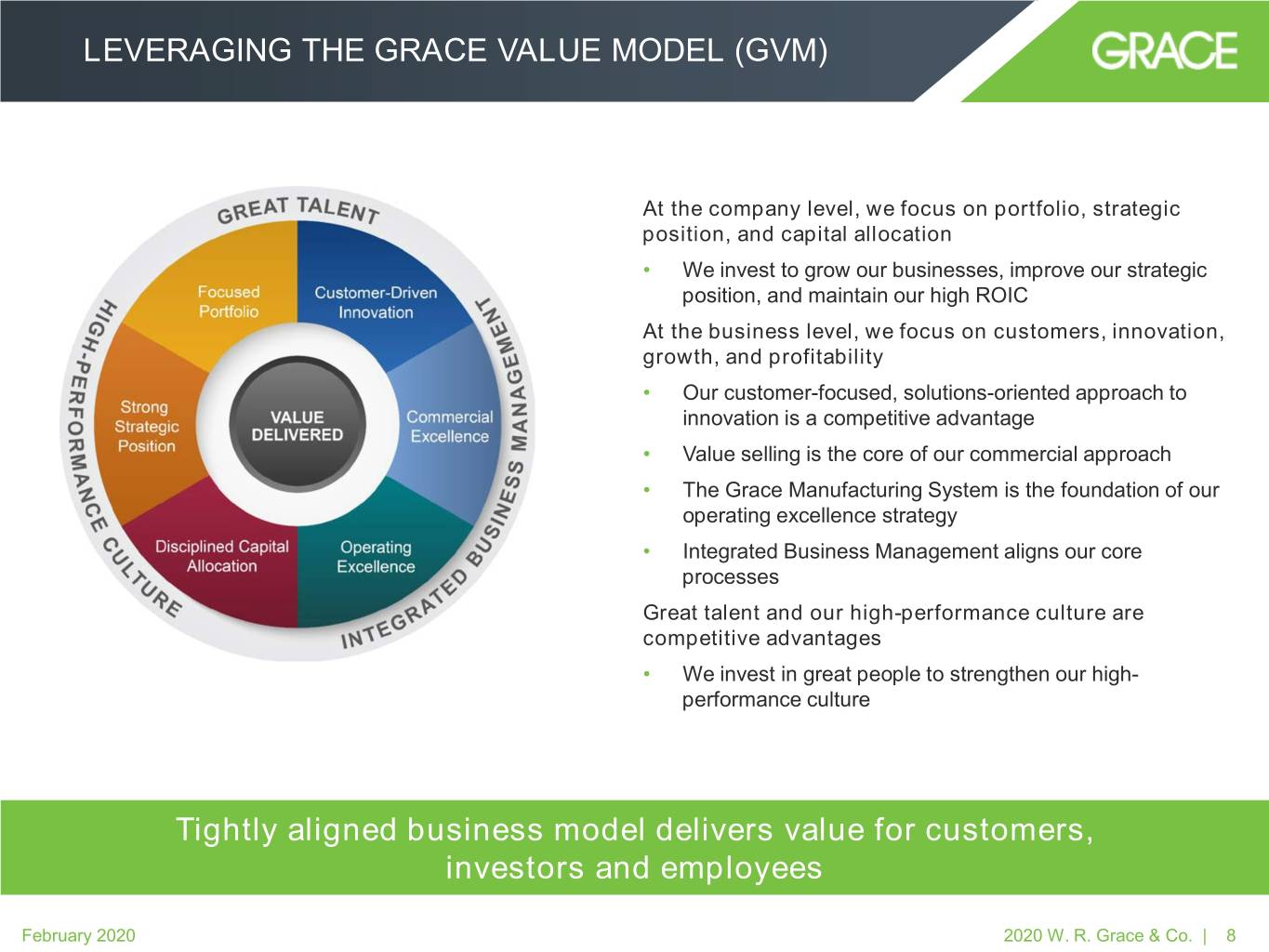
LEVERAGING THE GRACE VALUE MODEL (GVM) At the company level, we focus on portfolio, strategic position, and capital allocation • We invest to grow our businesses, improve our strategic position, and maintain our high ROIC At the business level, we focus on customers, innovation, growth, and profitability • Our customer-focused, solutions-oriented approach to innovation is a competitive advantage • Value selling is the core of our commercial approach • The Grace Manufacturing System is the foundation of our operating excellence strategy • Integrated Business Management aligns our core processes Great talent and our high-performance culture are competitive advantages • We invest in great people to strengthen our high- performance culture Tightly aligned business model delivers value for customers, investors and employees February 2020 2020 W. R. Grace & Co. | 8
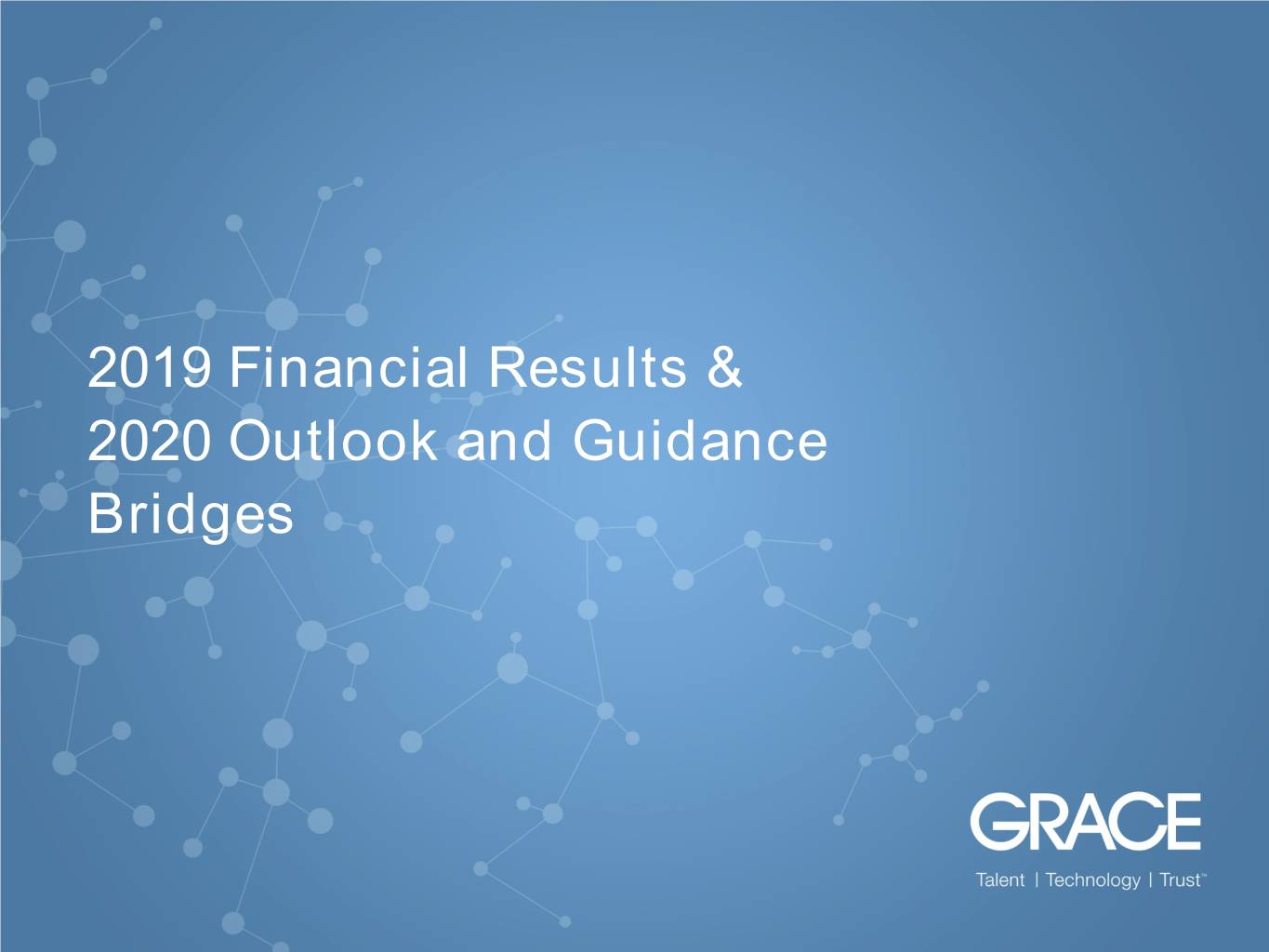
2019 Financial Results & 2020 Outlook and Guidance Bridges 9
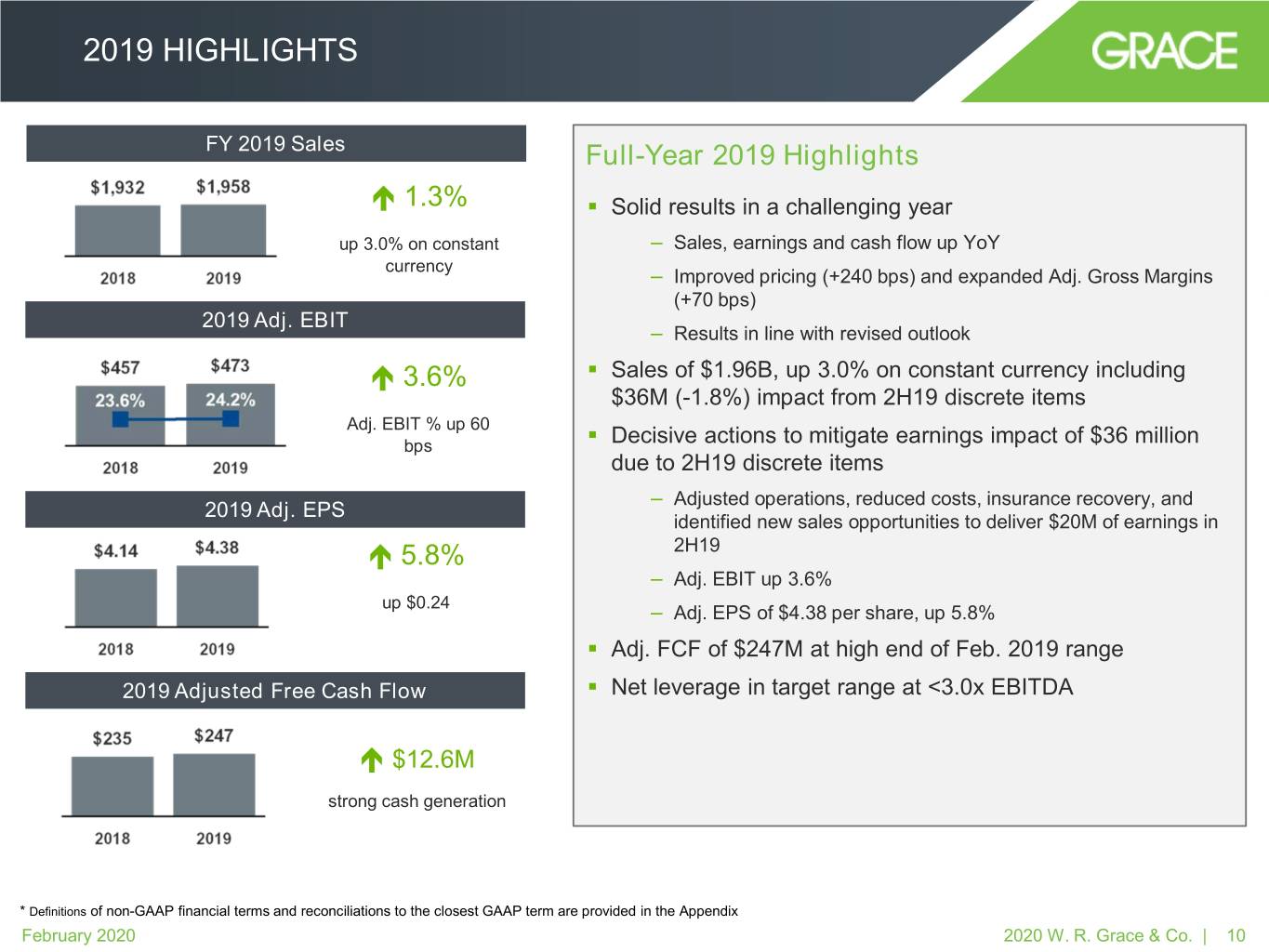
2019 HIGHLIGHTS FY 2019 Sales Full-Year 2019 Highlights 1.3% . Solid results in a challenging year up 3.0% on constant – Sales, earnings and cash flow up YoY currency – Improved pricing (+240 bps) and expanded Adj. Gross Margins (+70 bps) 2019 Adj. EBIT – Results in line with revised outlook 3.6% . Sales of $1.96B, up 3.0% on constant currency including $36M (-1.8%) impact from 2H19 discrete items Adj. EBIT % up 60 . bps Decisive actions to mitigate earnings impact of $36 million due to 2H19 discrete items – Adjusted operations, reduced costs, insurance recovery, and 2019 Adj. EPS identified new sales opportunities to deliver $20M of earnings in 5.8% 2H19 – Adj. EBIT up 3.6% up $0.24 – Adj. EPS of $4.38 per share, up 5.8% . Adj. FCF of $247M at high end of Feb. 2019 range 2019 Adjusted Free Cash Flow . Net leverage in target range at <3.0x EBITDA $12.6M strong cash generation * Definitions of non-GAAP financial terms and reconciliations to the closest GAAP term are provided in the Appendix February 2020 2020 W. R. Grace & Co. | 10

OUR STRATEGY FOR PROFITABLE GROWTH 1 Invest to accelerate Strengthening our Foundation growth and extend our • Over $250 million growth capacity investments since 2017 competitive advantages – Three major capacity additions coming online in 2020 for polyolefin catalysts, hydroprocessing catalysts and colloidal silica 2 – 90% of capital spending linked to specific customers, contracts, or Invest in great people polypropylene licenses to strengthen our • Commitment to Customer-Driven Innovation and Commercial high-performance culture Excellence – $6M and >50,000 employee hours invested to upgrade commercial 3 capabilities to drive win rates, share of wallet, and profitability 3 Execute the • Over $20 million invested in the Grace Manufacturing System Grace Value Model and Operating Excellence to drive operating excellence – GMS investments contributed 75 bps to margins in 2019 – Impact 50% higher than original benefit expectations 4 Acquire to build our • Paybacks will accelerate in 2020 and 2021 with new capacity and technology and manufacturing other investments maturing capabilities for our customers Confident in Strategic Direction and Earnings Power February 2020 2020 W. R. Grace & Co. | 11
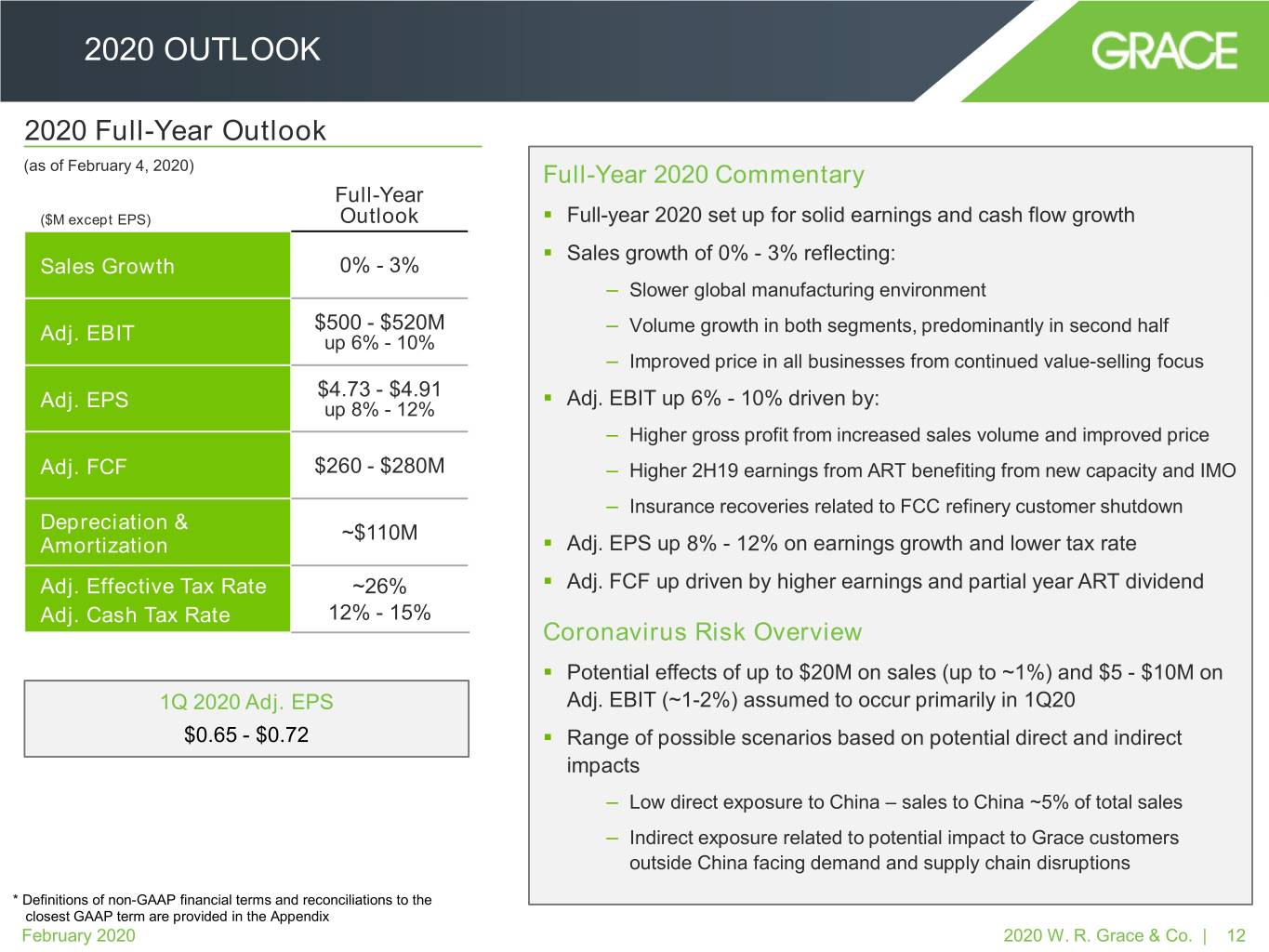
2020 OUTLOOK 2020 Full-Year Outlook (as of February 4, 2020) Full-Year 2020 Commentary Full-Year ($M except EPS) Outlook . Full-year 2020 set up for solid earnings and cash flow growth . Sales growth of 0% - 3% reflecting: Sales Growth 0% - 3% – Slower global manufacturing environment $500 - $520M – Volume growth in both segments, predominantly in second half Adj. EBIT up 6% - 10% – Improved price in all businesses from continued value-selling focus $4.73 - $4.91 . Adj. EBIT up 6% - 10% driven by: Adj. EPS up 8% - 12% – Higher gross profit from increased sales volume and improved price Adj. FCF $260 - $280M – Higher 2H19 earnings from ART benefiting from new capacity and IMO – Insurance recoveries related to FCC refinery customer shutdown Depreciation & ~$110M Amortization . Adj. EPS up 8% - 12% on earnings growth and lower tax rate Adj. Effective Tax Rate ~26% . Adj. FCF up driven by higher earnings and partial year ART dividend Adj. Cash Tax Rate 12% - 15% Coronavirus Risk Overview . Potential effects of up to $20M on sales (up to ~1%) and $5 - $10M on 1Q 2020 Adj. EPS Adj. EBIT (~1-2%) assumed to occur primarily in 1Q20 $0.65 - $0.72 . Range of possible scenarios based on potential direct and indirect impacts – Low direct exposure to China – sales to China ~5% of total sales – Indirect exposure related to potential impact to Grace customers outside China facing demand and supply chain disruptions * Definitions of non-GAAP financial terms and reconciliations to the closest GAAP term are provided in the Appendix February 2020 2020 W. R. Grace & Co. | 12
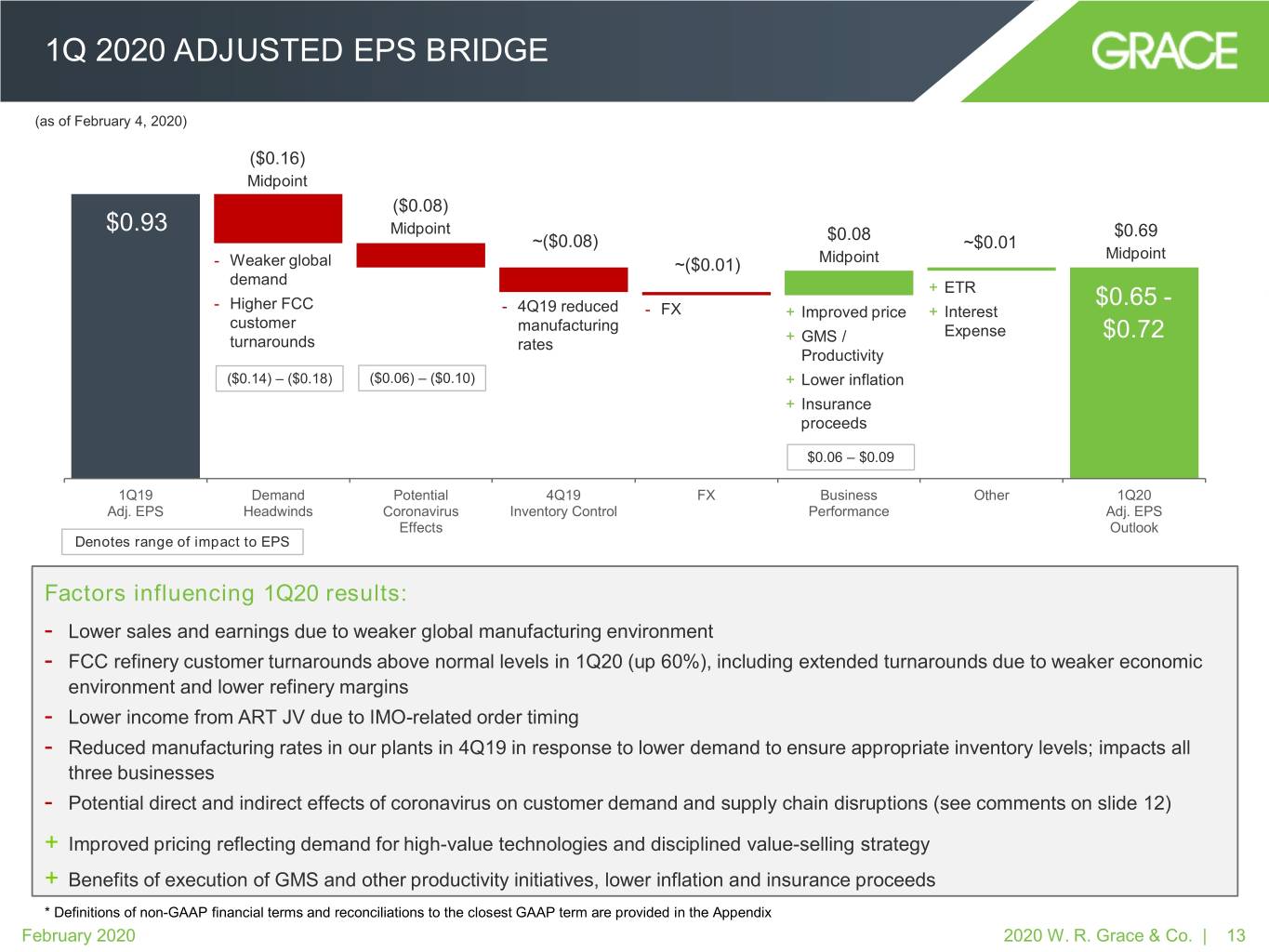
1Q 2020 ADJUSTED EPS BRIDGE (as of February 4, 2020) ($0.16) Midpoint ($0.08) $0.93 Midpoint $0.69 ~($0.08) $0.08 ~$0.01 Midpoint Midpoint - Weaker global ~($0.01) demand + ETR - Higher FCC $0.65 - - 4Q19 reduced - FX + Improved price + Interest customer manufacturing + GMS / Expense $0.72 turnarounds rates Productivity ($0.14) – ($0.18) ($0.06) – ($0.10) + Lower inflation + Insurance proceeds $0.06 – $0.09 1Q19 Demand Potential 4Q19 FX Business Other 1Q20 Adj. EPS Headwinds Coronavirus Inventory Control Performance Adj. EPS Effects Outlook Denotes range of impact to EPS Factors influencing 1Q20 results: - Lower sales and earnings due to weaker global manufacturing environment - FCC refinery customer turnarounds above normal levels in 1Q20 (up 60%), including extended turnarounds due to weaker economic environment and lower refinery margins - Lower income from ART JV due to IMO-related order timing - Reduced manufacturing rates in our plants in 4Q19 in response to lower demand to ensure appropriate inventory levels; impacts all three businesses - Potential direct and indirect effects of coronavirus on customer demand and supply chain disruptions (see comments on slide 12) + Improved pricing reflecting demand for high-value technologies and disciplined value-selling strategy + Benefits of execution of GMS and other productivity initiatives, lower inflation and insurance proceeds * Definitions of non-GAAP financial terms and reconciliations to the closest GAAP term are provided in the Appendix February 2020 2020 W. R. Grace & Co. | 13

2Q-4Q 2020 ADJUSTED EPS BRIDGE (as of February 4, 2020) $4.82 $0.27 ~$0.01 Midpoint Midpoint + ETR + FX $4.73 - ~$0.40 - Interest Expense $4.91 ($0.24) + Volume growth Midpoint + Improved price + GMS/Productivity 2020 Adj. EPS $4.38 + Lower inflation 8%-12% up $0.35 - $0.53 - 1Q YoY decline $0.23 – $0.33 ($0.21) – ($0.28) 2019 Adj. EPS 1Q YoY decline 2019 Discrete Items Business Performance Other 2020 Adj. EPS Outlook Denotes range of impact to EPS Factors influencing 2Q-4Q 2020 results: + Adj. EPS outlook for 2Q-4Q 2020 is up ~20% year-over-year, supported by: - ~$0.40 per share related to 2019 discrete items, or ~12% growth for the period - $0.27 per share related to improved business performance, or ~8% organic growth for the period + Sales and earnings growth driven by higher sales volumes and improved pricing in all businesses - Major capacity additions in Materials Technologies (colloidal silica) and Specialty Catalysts (polyolefin catalysts) - Lower FCC turnarounds as compared to historical periods - Higher earnings from ART JV in second half with new capacity (15-20% earnings contributions) and back-end loaded customer orders + Improved manufacturing costs benefiting from GMS, productivity and lower inflation * Definitions of non-GAAP financial terms and reconciliations to the closest GAAP term are provided in the Appendix February 2020 2020 W. R. Grace & Co. | 14
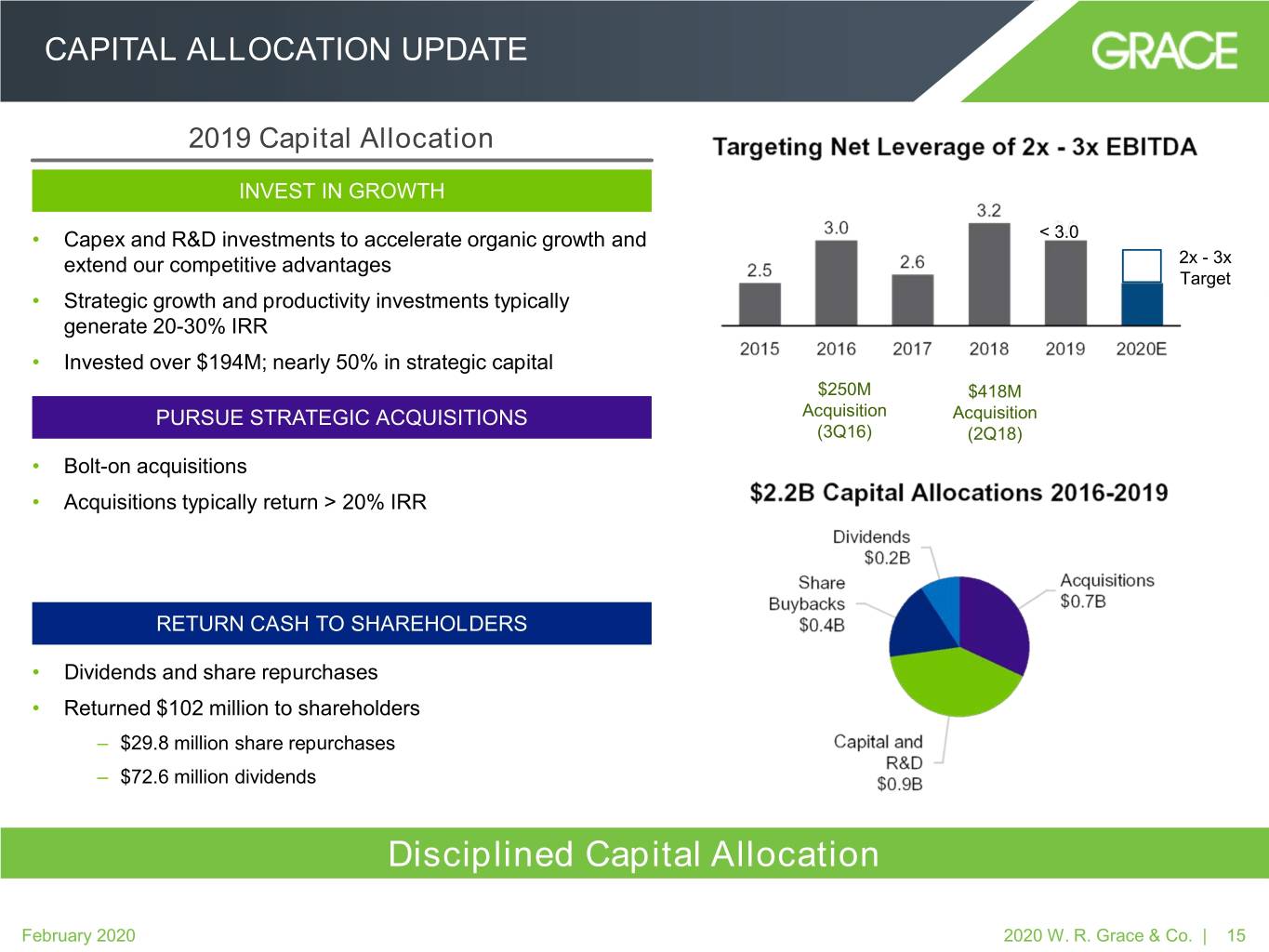
CAPITAL ALLOCATION UPDATE 2019 Capital Allocation INVEST IN GROWTH • Capex and R&D investments to accelerate organic growth and < 3.0 extend our competitive advantages 2x - 3x Target • Strategic growth and productivity investments typically generate 20-30% IRR • Invested over $194M; nearly 50% in strategic capital $250M $418M PURSUE STRATEGIC ACQUISITIONS Acquisition Acquisition (3Q16) (2Q18) • Bolt-on acquisitions • Acquisitions typically return > 20% IRR RETURN CASH TO SHAREHOLDERS • Dividends and share repurchases • Returned $102 million to shareholders – $29.8 million share repurchases – $72.6 million dividends Disciplined Capital Allocation February 2020 2020 W. R. Grace & Co. | 15
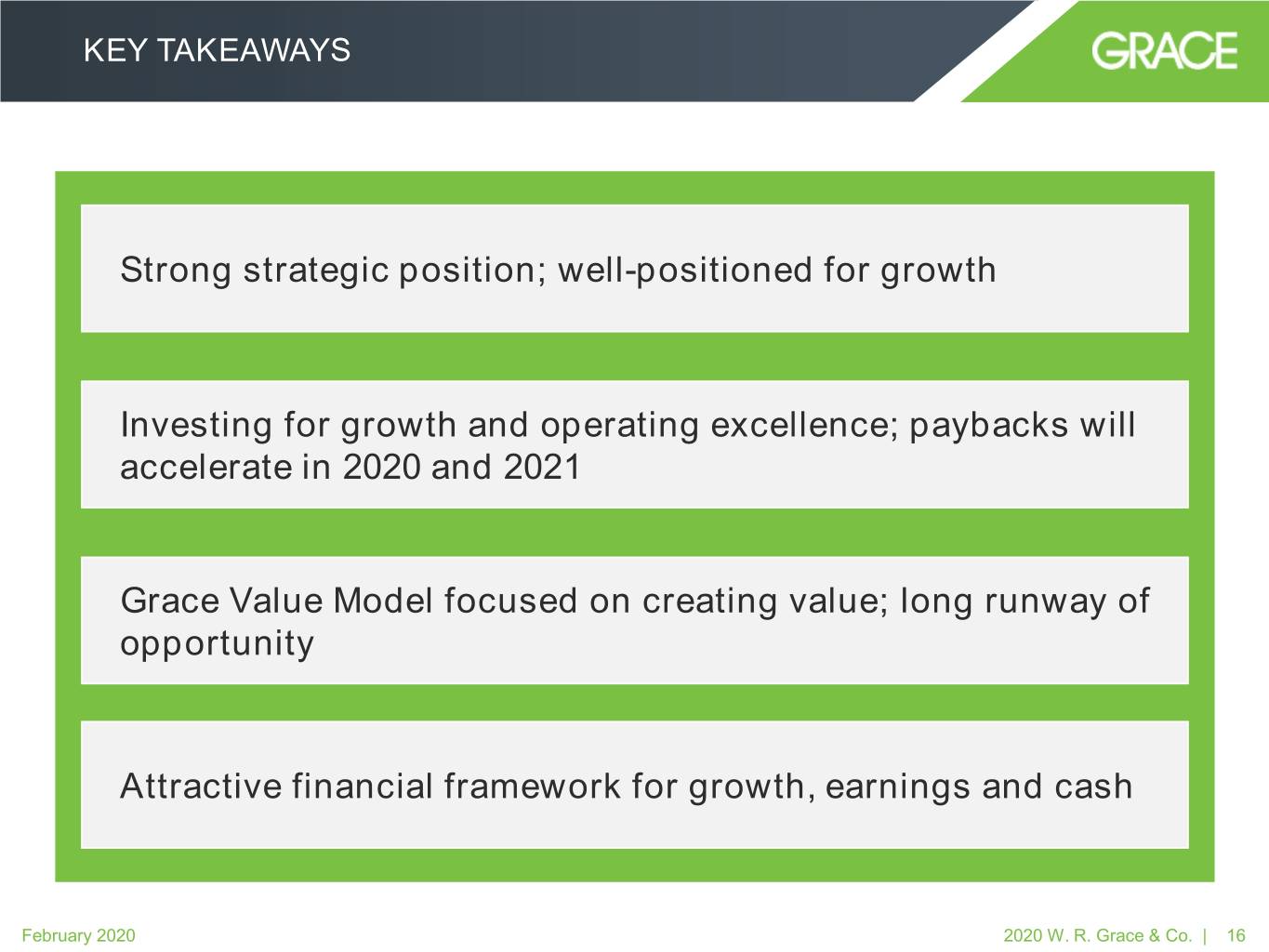
KEY TAKEAWAYS Strong strategic position; well-positioned for growth Investing for growth and operating excellence; paybacks will accelerate in 2020 and 2021 Grace Value Model focused on creating value; long runway of opportunity Attractive financial framework for growth, earnings and cash February 2020 2020 W. R. Grace & Co. | 16

Supplemental Information 17
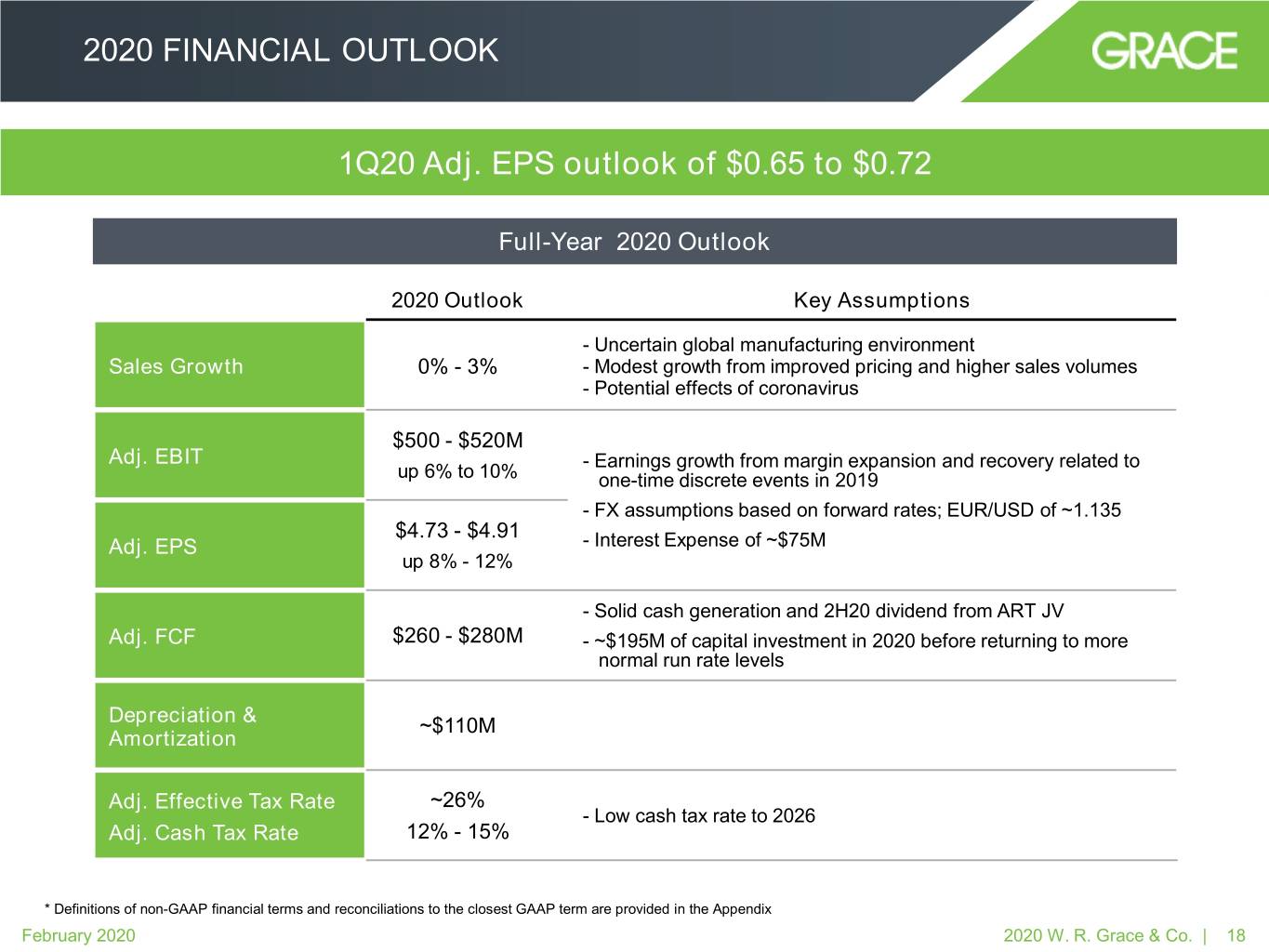
2020 FINANCIAL OUTLOOK 1Q20 Adj. EPS outlook of $0.65 to $0.72 Full-Year 2020 Outlook 2020 Outlook Key Assumptions - Uncertain global manufacturing environment Sales Growth 0% - 3% - Modest growth from improved pricing and higher sales volumes - Potential effects of coronavirus $500 - $520M Adj. EBIT - Earnings growth from margin expansion and recovery related to up 6% to 10% one-time discrete events in 2019 - FX assumptions based on forward rates; EUR/USD of ~1.135 $4.73 - $4.91 Adj. EPS - Interest Expense of ~$75M up 8% - 12% - Solid cash generation and 2H20 dividend from ART JV Adj. FCF $260 - $280M - ~$195M of capital investment in 2020 before returning to more normal run rate levels Depreciation & ~$110M Amortization Adj. Effective Tax Rate ~26% - Low cash tax rate to 2026 Adj. Cash Tax Rate 12% - 15% * Definitions of non-GAAP financial terms and reconciliations to the closest GAAP term are provided in the Appendix February 2020 2020 W. R. Grace & Co. | 18
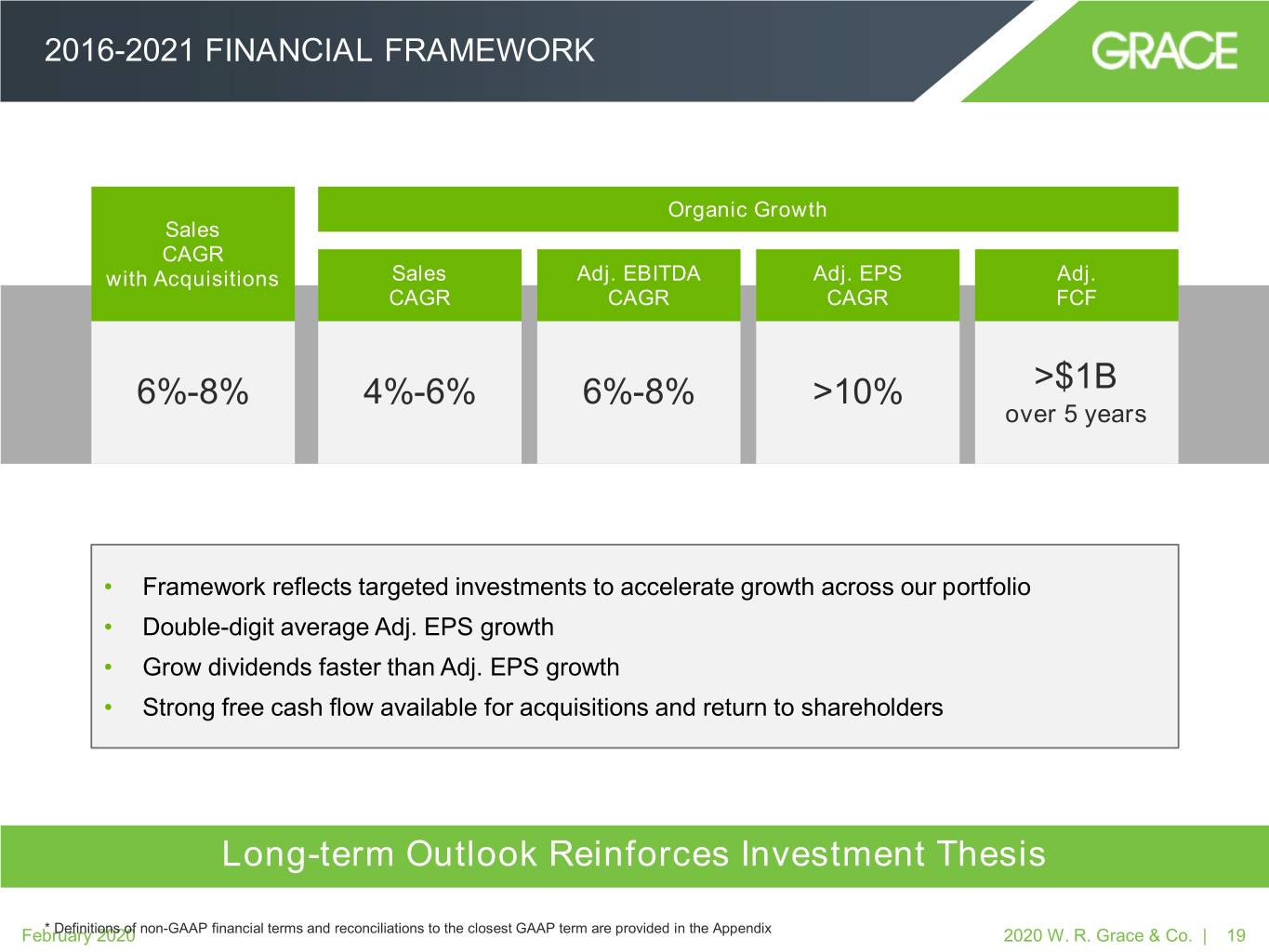
2016-2021 FINANCIAL FRAMEWORK Organic Growth Sales CAGR with Acquisitions Sales Adj. EBITDA Adj. EPS Adj. CAGR CAGR CAGR FCF 6%-8% 4%-6% 6%-8% >10% >$1B over 5 years • Framework reflects targeted investments to accelerate growth across our portfolio • Double-digit average Adj. EPS growth • Grow dividends faster than Adj. EPS growth • Strong free cash flow available for acquisitions and return to shareholders Long-term Outlook Reinforces Investment Thesis February* Definitions 2020 of non-GAAP financial terms and reconciliations to the closest GAAP term are provided in the Appendix 2020 W. R. Grace & Co. | 19
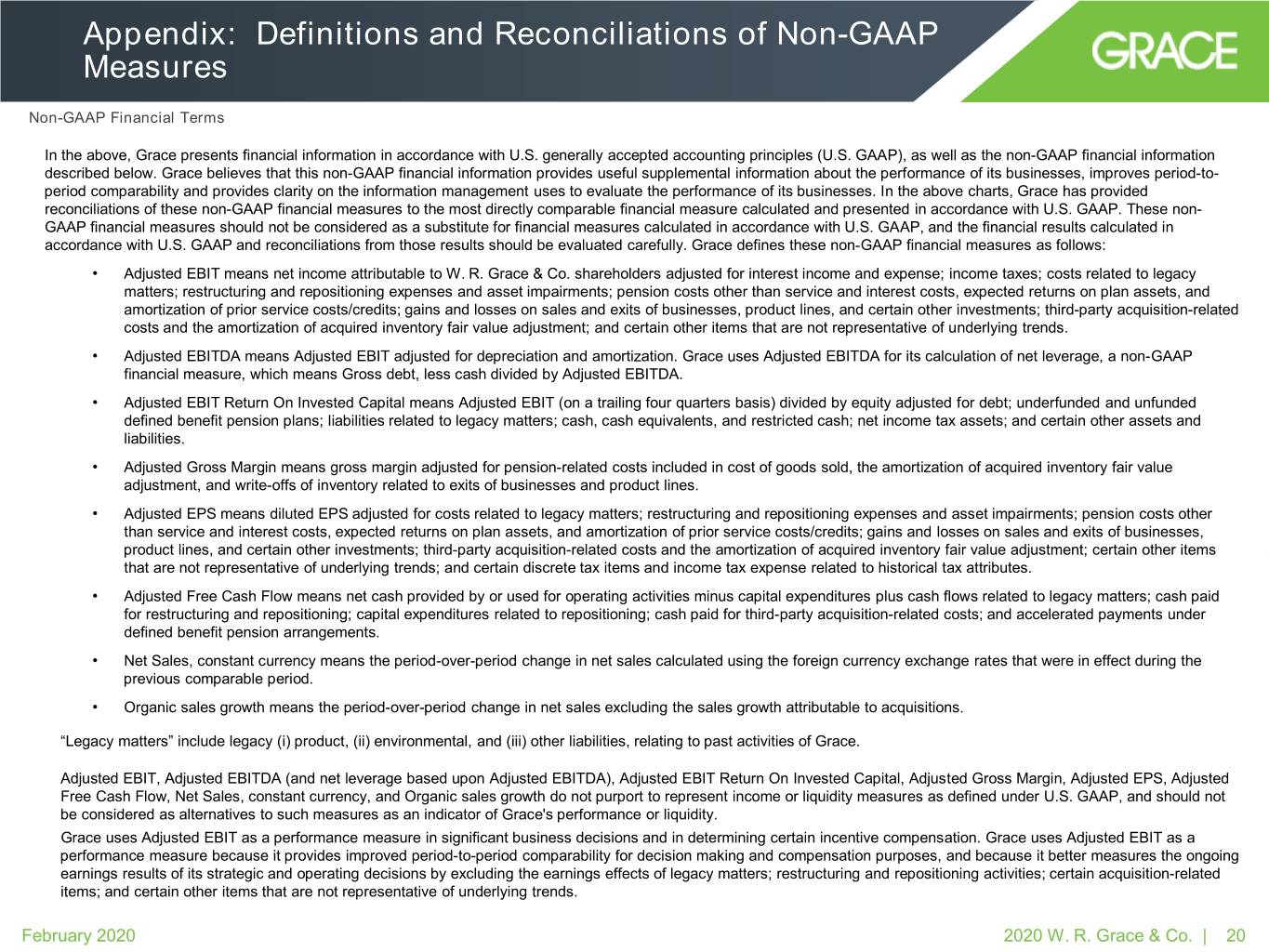
Appendix: Definitions and Reconciliations of Non-GAAP Measures Non-GAAP Financial Terms In the above, Grace presents financial information in accordance with U.S. generally accepted accounting principles (U.S. GAAP), as well as the non-GAAP financial information described below. Grace believes that this non-GAAP financial information provides useful supplemental information about the performance of its businesses, improves period-to- period comparability and provides clarity on the information management uses to evaluate the performance of its businesses. In the above charts, Grace has provided reconciliations of these non-GAAP financial measures to the most directly comparable financial measure calculated and presented in accordance with U.S. GAAP. These non- GAAP financial measures should not be considered as a substitute for financial measures calculated in accordance with U.S. GAAP, and the financial results calculated in accordance with U.S. GAAP and reconciliations from those results should be evaluated carefully. Grace defines these non-GAAP financial measures as follows: • Adjusted EBIT means net income attributable to W. R. Grace & Co. shareholders adjusted for interest income and expense; income taxes; costs related to legacy matters; restructuring and repositioning expenses and asset impairments; pension costs other than service and interest costs, expected returns on plan assets, and amortization of prior service costs/credits; gains and losses on sales and exits of businesses, product lines, and certain other investments; third-party acquisition-related costs and the amortization of acquired inventory fair value adjustment; and certain other items that are not representative of underlying trends. • Adjusted EBITDA means Adjusted EBIT adjusted for depreciation and amortization. Grace uses Adjusted EBITDA for its calculation of net leverage, a non-GAAP financial measure, which means Gross debt, less cash divided by Adjusted EBITDA. • Adjusted EBIT Return On Invested Capital means Adjusted EBIT (on a trailing four quarters basis) divided by equity adjusted for debt; underfunded and unfunded defined benefit pension plans; liabilities related to legacy matters; cash, cash equivalents, and restricted cash; net income tax assets; and certain other assets and liabilities. • Adjusted Gross Margin means gross margin adjusted for pension-related costs included in cost of goods sold, the amortization of acquired inventory fair value adjustment, and write-offs of inventory related to exits of businesses and product lines. • Adjusted EPS means diluted EPS adjusted for costs related to legacy matters; restructuring and repositioning expenses and asset impairments; pension costs other than service and interest costs, expected returns on plan assets, and amortization of prior service costs/credits; gains and losses on sales and exits of businesses, product lines, and certain other investments; third-party acquisition-related costs and the amortization of acquired inventory fair value adjustment; certain other items that are not representative of underlying trends; and certain discrete tax items and income tax expense related to historical tax attributes. • Adjusted Free Cash Flow means net cash provided by or used for operating activities minus capital expenditures plus cash flows related to legacy matters; cash paid for restructuring and repositioning; capital expenditures related to repositioning; cash paid for third-party acquisition-related costs; and accelerated payments under defined benefit pension arrangements. • Net Sales, constant currency means the period-over-period change in net sales calculated using the foreign currency exchange rates that were in effect during the previous comparable period. • Organic sales growth means the period-over-period change in net sales excluding the sales growth attributable to acquisitions. “Legacy matters” include legacy (i) product, (ii) environmental, and (iii) other liabilities, relating to past activities of Grace. Adjusted EBIT, Adjusted EBITDA (and net leverage based upon Adjusted EBITDA), Adjusted EBIT Return On Invested Capital, Adjusted Gross Margin, Adjusted EPS, Adjusted Free Cash Flow, Net Sales, constant currency, and Organic sales growth do not purport to represent income or liquidity measures as defined under U.S. GAAP, and should not be considered as alternatives to such measures as an indicator of Grace's performance or liquidity. Grace uses Adjusted EBIT as a performance measure in significant business decisions and in determining certain incentive compensation. Grace uses Adjusted EBIT as a performance measure because it provides improved period-to-period comparability for decision making and compensation purposes, and because it better measures the ongoing earnings results of its strategic and operating decisions by excluding the earnings effects of legacy matters; restructuring and repositioning activities; certain acquisition-related items; and certain other items that are not representative of underlying trends. February 2020 2020 W. R. Grace & Co. | 20
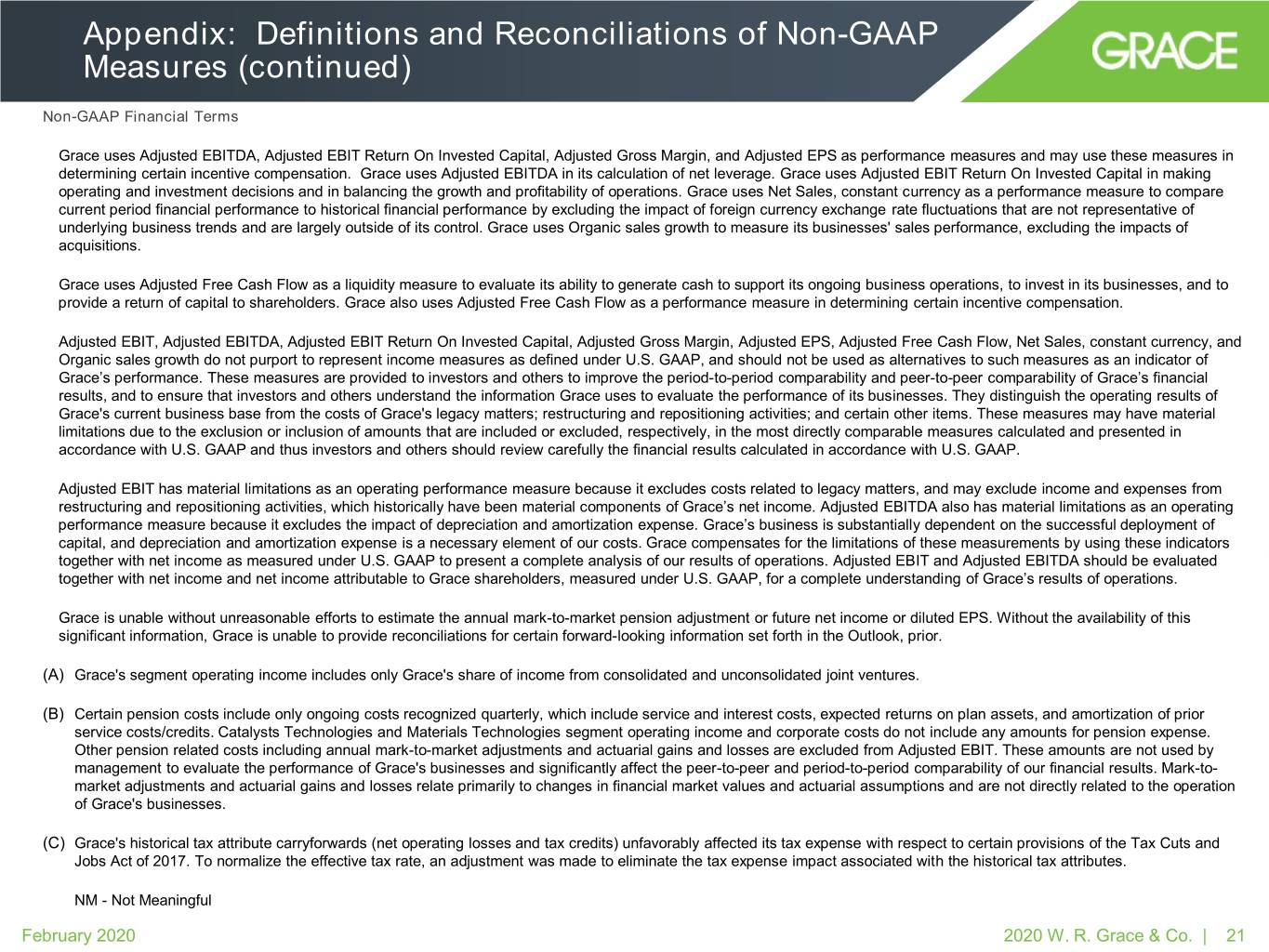
Appendix: Definitions and Reconciliations of Non-GAAP Measures (continued) Non-GAAP Financial Terms Grace uses Adjusted EBITDA, Adjusted EBIT Return On Invested Capital, Adjusted Gross Margin, and Adjusted EPS as performance measures and may use these measures in determining certain incentive compensation. Grace uses Adjusted EBITDA in its calculation of net leverage. Grace uses Adjusted EBIT Return On Invested Capital in making operating and investment decisions and in balancing the growth and profitability of operations. Grace uses Net Sales, constant currency as a performance measure to compare current period financial performance to historical financial performance by excluding the impact of foreign currency exchange rate fluctuations that are not representative of underlying business trends and are largely outside of its control. Grace uses Organic sales growth to measure its businesses' sales performance, excluding the impacts of acquisitions. Grace uses Adjusted Free Cash Flow as a liquidity measure to evaluate its ability to generate cash to support its ongoing business operations, to invest in its businesses, and to provide a return of capital to shareholders. Grace also uses Adjusted Free Cash Flow as a performance measure in determining certain incentive compensation. Adjusted EBIT, Adjusted EBITDA, Adjusted EBIT Return On Invested Capital, Adjusted Gross Margin, Adjusted EPS, Adjusted Free Cash Flow, Net Sales, constant currency, and Organic sales growth do not purport to represent income measures as defined under U.S. GAAP, and should not be used as alternatives to such measures as an indicator of Grace’s performance. These measures are provided to investors and others to improve the period-to-period comparability and peer-to-peer comparability of Grace’s financial results, and to ensure that investors and others understand the information Grace uses to evaluate the performance of its businesses. They distinguish the operating results of Grace's current business base from the costs of Grace's legacy matters; restructuring and repositioning activities; and certain other items. These measures may have material limitations due to the exclusion or inclusion of amounts that are included or excluded, respectively, in the most directly comparable measures calculated and presented in accordance with U.S. GAAP and thus investors and others should review carefully the financial results calculated in accordance with U.S. GAAP. Adjusted EBIT has material limitations as an operating performance measure because it excludes costs related to legacy matters, and may exclude income and expenses from restructuring and repositioning activities, which historically have been material components of Grace’s net income. Adjusted EBITDA also has material limitations as an operating performance measure because it excludes the impact of depreciation and amortization expense. Grace’s business is substantially dependent on the successful deployment of capital, and depreciation and amortization expense is a necessary element of our costs. Grace compensates for the limitations of these measurements by using these indicators together with net income as measured under U.S. GAAP to present a complete analysis of our results of operations. Adjusted EBIT and Adjusted EBITDA should be evaluated together with net income and net income attributable to Grace shareholders, measured under U.S. GAAP, for a complete understanding of Grace’s results of operations. Grace is unable without unreasonable efforts to estimate the annual mark-to-market pension adjustment or future net income or diluted EPS. Without the availability of this significant information, Grace is unable to provide reconciliations for certain forward-looking information set forth in the Outlook, prior. (A) Grace's segment operating income includes only Grace's share of income from consolidated and unconsolidated joint ventures. (B) Certain pension costs include only ongoing costs recognized quarterly, which include service and interest costs, expected returns on plan assets, and amortization of prior service costs/credits. Catalysts Technologies and Materials Technologies segment operating income and corporate costs do not include any amounts for pension expense. Other pension related costs including annual mark-to-market adjustments and actuarial gains and losses are excluded from Adjusted EBIT. These amounts are not used by management to evaluate the performance of Grace's businesses and significantly affect the peer-to-peer and period-to-period comparability of our financial results. Mark-to- market adjustments and actuarial gains and losses relate primarily to changes in financial market values and actuarial assumptions and are not directly related to the operation of Grace's businesses. (C) Grace's historical tax attribute carryforwards (net operating losses and tax credits) unfavorably affected its tax expense with respect to certain provisions of the Tax Cuts and Jobs Act of 2017. To normalize the effective tax rate, an adjustment was made to eliminate the tax expense impact associated with the historical tax attributes. NM - Not Meaningful February 2020 2020 W. R. Grace & Co. | 21
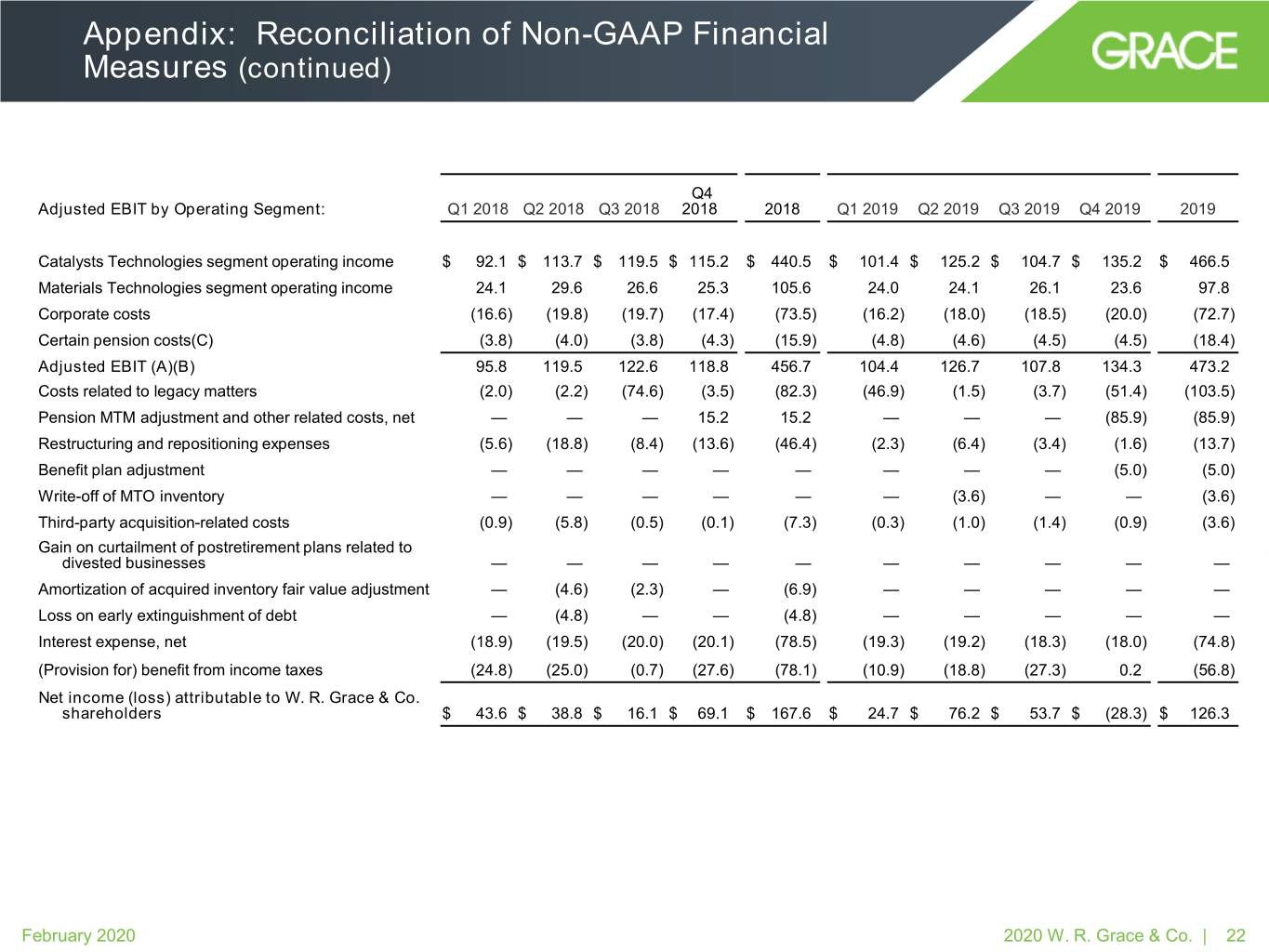
Appendix: Reconciliation of Non-GAAP Financial Measures (continued) Q4 Adjusted EBIT by Operating Segment: Q1 2018 Q2 2018 Q3 2018 2018 2018 Q1 2019 Q2 2019 Q3 2019 Q4 2019 2019 Catalysts Technologies segment operating income $ 92.1 $ 113.7 $ 119.5 $ 115.2 $ 440.5 $ 101.4 $ 125.2 $ 104.7 $ 135.2 $ 466.5 Materials Technologies segment operating income 24.1 29.6 26.6 25.3 105.6 24.0 24.1 26.1 23.6 97.8 Corporate costs (16.6) (19.8) (19.7) (17.4) (73.5) (16.2) (18.0) (18.5) (20.0) (72.7) Certain pension costs(C) (3.8) (4.0) (3.8) (4.3) (15.9) (4.8) (4.6) (4.5) (4.5) (18.4) Adjusted EBIT (A)(B) 95.8 119.5 122.6 118.8 456.7 104.4 126.7 107.8 134.3 473.2 Costs related to legacy matters (2.0) (2.2) (74.6) (3.5) (82.3) (46.9) (1.5) (3.7) (51.4) (103.5) Pension MTM adjustment and other related costs, net — — — 15.2 15.2 — — — (85.9) (85.9) Restructuring and repositioning expenses (5.6) (18.8) (8.4) (13.6) (46.4) (2.3) (6.4) (3.4) (1.6) (13.7) Benefit plan adjustment — — — — — — — — (5.0) (5.0) Write-off of MTO inventory — — — — — — (3.6) — — (3.6) Third-party acquisition-related costs (0.9) (5.8) (0.5) (0.1) (7.3) (0.3) (1.0) (1.4) (0.9) (3.6) Gain on curtailment of postretirement plans related to divested businesses — — — — — — — — — — Amortization of acquired inventory fair value adjustment — (4.6) (2.3) — (6.9) — — — — — Loss on early extinguishment of debt — (4.8) — — (4.8) — — — — — Interest expense, net (18.9) (19.5) (20.0) (20.1) (78.5) (19.3) (19.2) (18.3) (18.0) (74.8) (Provision for) benefit from income taxes (24.8) (25.0) (0.7) (27.6) (78.1) (10.9) (18.8) (27.3) 0.2 (56.8) Net income (loss) attributable to W. R. Grace & Co. shareholders $ 43.6 $ 38.8 $ 16.1 $ 69.1 $ 167.6 $ 24.7 $ 76.2 $ 53.7 $ (28.3) $ 126.3 February 2020 2020 W. R. Grace & Co. | 22

Appendix: Reconciliation of Non-GAAP Financial Measures (continued) Adjusted Free Cash Flow (A): YTD 2019 YTD 2018 Net cash provided by (used for) operating activities 392.1 342.0 Capital expenditures (194.1) (216.3) Free Cash Flow 198.0 125.7 Cash paid for legacy product, environmental and other claims 19.3 22.9 Cash paid for repositioning 16.8 20.7 Cash paid for third-party acquisition-related costs 2.9 9.2 Cash paid for restructuring 10.2 6.1 Accelerated defined benefit pension plan contributions — 50.0 Adjusted Free Cash Flow 247.2 234.6 Calculation of Adjusted EBIT Return On Invested Capital (trailing four quarters): Q4 2019 Q4 2018 Adjusted EBIT $ 473.2 $ 456.7 Net Income 126.3 167.6 Total equity 402.2 337.0 Reconciliation to Invested Capital: Debt 1,980.4 1,983.3 Underfunded and unfunded pension plans 519.8 433.1 Liabilities related to legacy matters 182.7 126.9 Cash, cash equivalents, and restricted cash (282.9) (201.0) Net income tax assets (501.6) (517.3) Other items 19.7 21.6 Adjusted Invested Capital $ 2,320.3 2,183.6 GAAP Return on Equity 31.4% 49.7% Adjusted EBIT ROIC 20.4% 20.9% February 2020 2020 W. R. Grace & Co. | 23

Appendix: Reconciliation of Non-GAAP Financial Measures (continued) Three Months Ended December 31, 2019 2018 Tax After Per Tax After Per (In millions, except per share amounts) Pre-Tax Effect Tax Share Pre-Tax Effect Tax Share Diluted earnings per share $ (0.42) $ 1.03 Pension MTM adjustment and other related costs, net 85.9 24.0 61.9 0.93 (15.2) (5.5) (9.7) (0.14) Costs (benefit) related to legacy product, environmental and other claims 51.4 11.1 40.3 0.60 3.5 0.8 2.7 0.04 Benefit plan adjustment $ 5.0 $ 1.1 $ 3.9 0.06 $ — $ — $ — — Restructuring and repositioning expenses $ 1.6 $ 0.4 $ 1.2 0.02 $ 13.6 $ 2.9 $ 10.7 0.16 Third-party acquisition-related costs 0.9 0.2 0.7 0.01 0.1 — 0.1 — Income tax expense related to historical tax attributes 1.4 (1.4) (0.02) (14.3) 14.3 0.21 Provisional charge related to the U.S. Tax Cuts and Jobs Act of 2017 — — — 9.4 (9.4) (0.14) Discrete tax items (8.4) 8.4 0.13 1.4 (1.4) (0.02) Adjusted EPS (A) $ 1.31 $ 1.14 February 2020 2020 W. R. Grace & Co. | 24
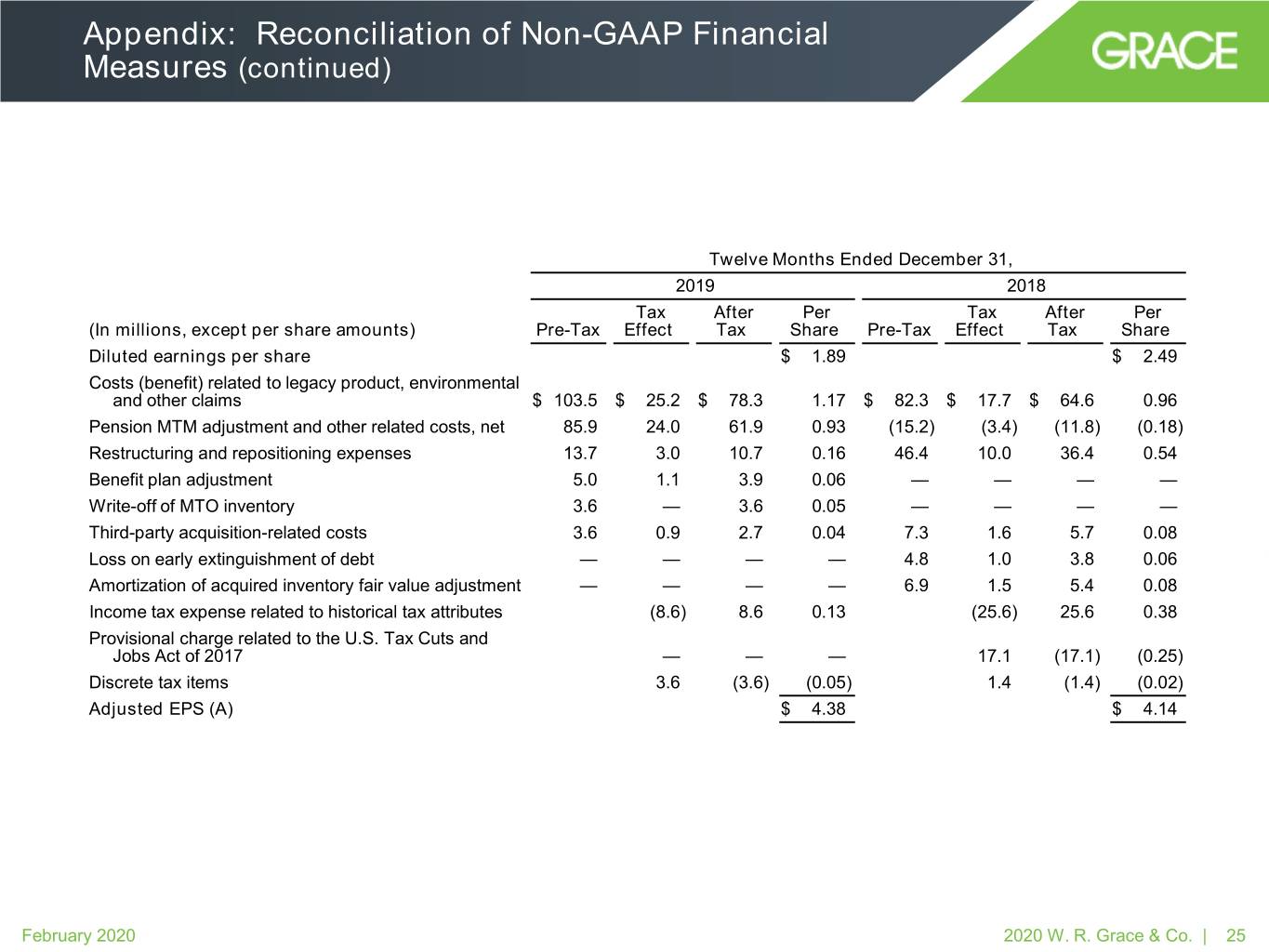
Appendix: Reconciliation of Non-GAAP Financial Measures (continued) Twelve Months Ended December 31, 2019 2018 Tax After Per Tax After Per (In millions, except per share amounts) Pre-Tax Effect Tax Share Pre-Tax Effect Tax Share Diluted earnings per share $ 1.89 $ 2.49 Costs (benefit) related to legacy product, environmental and other claims $ 103.5 $ 25.2 $ 78.3 1.17 $ 82.3 $ 17.7 $ 64.6 0.96 Pension MTM adjustment and other related costs, net 85.9 24.0 61.9 0.93 (15.2) (3.4) (11.8) (0.18) Restructuring and repositioning expenses 13.7 3.0 10.7 0.16 46.4 10.0 36.4 0.54 Benefit plan adjustment 5.0 1.1 3.9 0.06 — — — — Write-off of MTO inventory 3.6 — 3.6 0.05 — — — — Third-party acquisition-related costs 3.6 0.9 2.7 0.04 7.3 1.6 5.7 0.08 Loss on early extinguishment of debt — — — — 4.8 1.0 3.8 0.06 Amortization of acquired inventory fair value adjustment — — — — 6.9 1.5 5.4 0.08 Income tax expense related to historical tax attributes (8.6) 8.6 0.13 (25.6) 25.6 0.38 Provisional charge related to the U.S. Tax Cuts and Jobs Act of 2017 — — — 17.1 (17.1) (0.25) Discrete tax items 3.6 (3.6) (0.05) 1.4 (1.4) (0.02) Adjusted EPS (A) $ 4.38 $ 4.14 February 2020 2020 W. R. Grace & Co. | 25
